
(Photo by Réunion Underwater Photography)
It's easy to look at a moray eel (F. Muraenidae) and imagine it to be some sort of underwater dragon, guarding the treasure within its cavernous lair. One species in particular has quite a unique appearance, and as a result carries a dragon-inspired name.
The dragon moray (Enchelycore pardalis), also known as the leopard moray, is found on coral reefs across much of the tropical and subtropical Indo-Pacific.
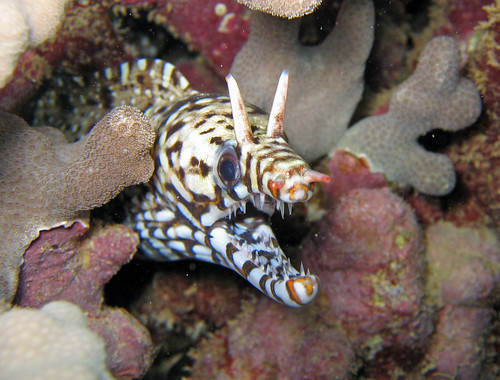
(Photo by lucero81)
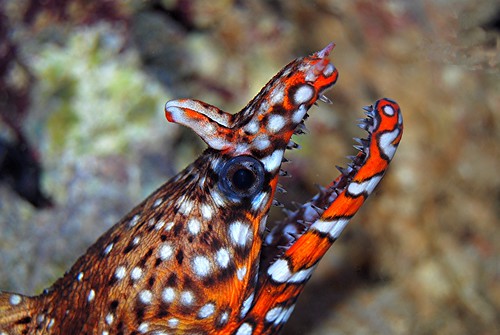
(Photo by Gmansquared)
The 'horns' on its head, which probably led to it being known as the dragon moray, are simply its nostrils. In general, all fishes have 2 pairs of nostrils. Water enters the front nasal tubes near the tip of the snout, passes through chambers where scents are picked up, and then exits via the rear nostrils near the eyes. This is how moray eels detect prey, despite having poor eyesight. Other moray eels possess these tubular nostrils, though these structures are not as elongated as those seen in the dragon moray.
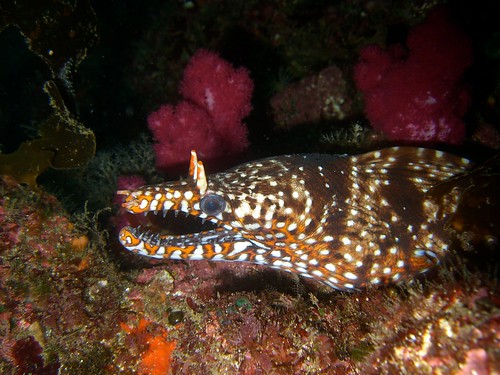
(Photo by marylkayoe)
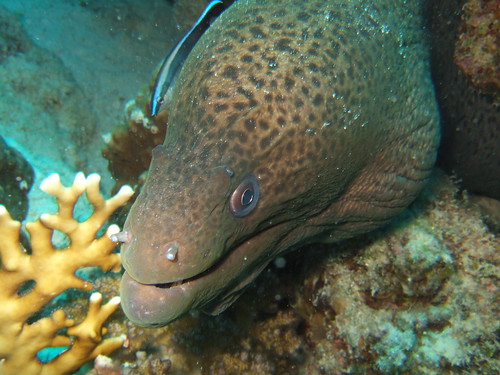
You can see both pairs of nostrils in this photo of a giant moray (Gymnothorax javanicus);
(Photo by Matt Wyatt)
Aside from its distinctive ornamentation, the dragon moray has the same long muscular body as that seen in other moray eels. It is somewhat smaller than many other species of moray eel, growing to 'only' around 92 centimetres in length. Largely nocturnal, this eel emerges at night to hunt for fishes, though it is likely that it also preys on crustaceans and cephalopods.
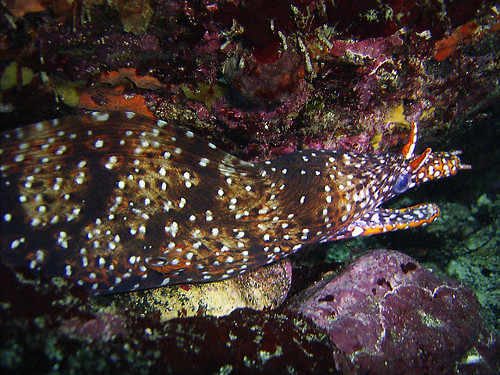
(Photo by I Like Fugu)
Shy and reclusive, the dragon moray is not often seen by divers, although it seems to be more regularly encountered on reefs and rocky areas in 2 regions, in Hawaii and the seas between the northern Philippines and southern Japan.
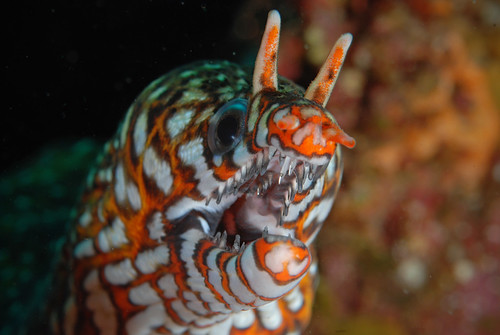
(Photo by Arne Kuilman)
Due to its exotic appearance, the dragon moray is highly popular in the marine aquarium trade, and because of its rarity, is very expensive. Browsing through online stores where one can order live fishes for the aquarium, dragon eels can range in price from US$795 to US$1,200.
Nobody has managed to breed moray eels in captivity, so the dragon morays seen in aquariums are definitely wild-caught. Depending on where the eels are collected, they are often labelled as Hawaiian or Japanese dragon morays, although they are all the same species.

(Photo by Nemo's great uncle)
Moray eels are definitely not recommended for beginners, requiring large aquariums with plenty of hiding places and powerful filtration systems to cope with all the waste produced on a meaty diet. Eels are also excellent escape artists, so the tank should have a secure cover to avoid having your expensive dragon moray ending its own life on the carpet. Given that the dragon moray will prey on small fishes, and has a reputation for being aggressive in general, it is probably best kept alone. Dragon morays can occasionally be kept in pairs, or with other similarly-sized or larger moray eel species in aquariums with enough caves for all, although this also depends a lot on individual personalities. The dragon moray could plausibly be kept with a shoal of small, fast-swimming (and cheap!) damselfishes, although some losses are probably inevitable. Cleaner shrimps might be tolerated, and provide an interesting display as they perch on the moray eel's face without fear of being harmed. Sessile invertebrates such as corals and fanworms should be safe as well. Aside from these issues, which are common to most moray eel species kept in captivity, caring for a dragon moray is relatively straightforward, and one can live for as long as 10 years. I suppose most people with the money to buy a dragon moray would at least make the effort to provide the living conditions and care required for such an expensive fish.

(Photo by CoasterReal)
I can't seem to find any legislation regulating the collection of dragon morays, and it appears that the species is rare in the wild to begin with. With most of the individuals being caught for the aquarium trade being juveniles, it raises the question as to whether certain populations might eventually become depleted due to excessive capture of young. Not to mention that there is always the possibility that some of these eels were collected using destructive methods such as cyanide fishing.

(Photo by UmizaruGoh)
A few other species of moray eel are also sometimes known as dragon morays. These all belong to the genus Muraena, which the dragon moray was once classified under, until it was determined to be distinctive enough and moved to Enchelycore in 1988. These species include the whitespot moray (Muraena pavonina), honeycomb moray (Muraena melanotis) and reticulate moray (Muraena retifera) from the western Atlantic, which are all confusingly called Brazilian dragon morays in the aquarium trade.
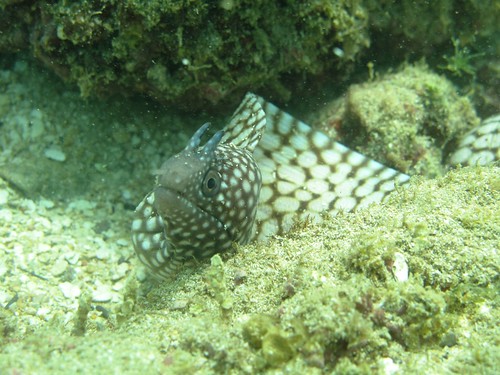
Whitespot moray;
(Photo by pedrohcp2)
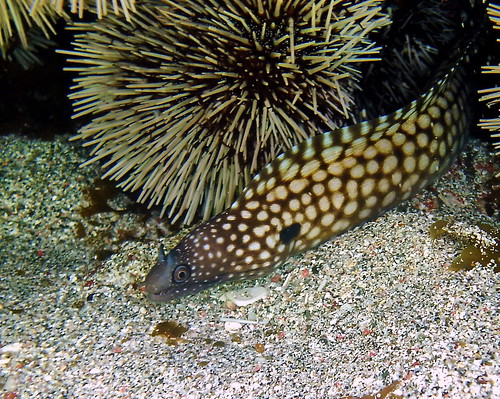
Reticulate moray;
(Photo by adri b brandao)
The honeycomb moray, which also occurs in the east Atlantic along the western coast of Africa, is sometimes called the African dragon moray.
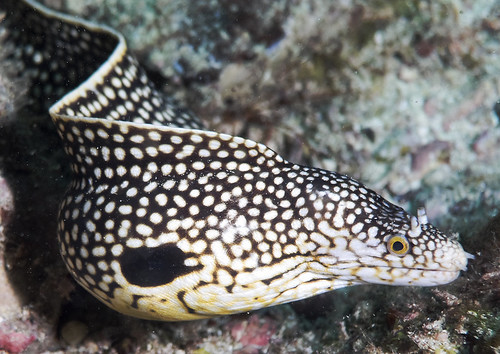
Honeycomb moray;
(Photo by wizbowes)
The jewel moray (Muraena lentiginosa) of the eastern Pacific also occasionally bears the name of Mexican dragon moray.
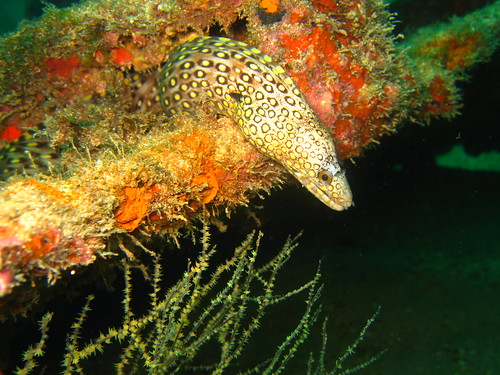
(Photo by nico&anouk)
Coming up, yet more dragon-like fishes.